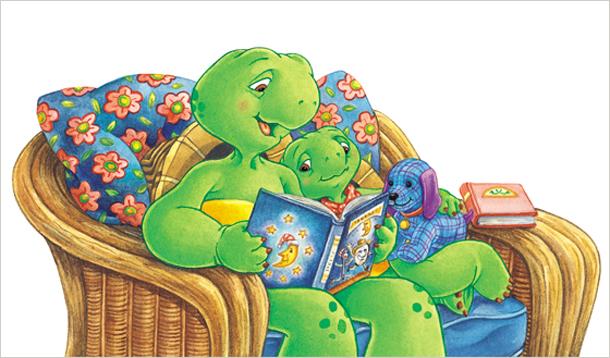
I love teaching through literature. Books have an amazing way of engaging kids and starting conversations. Great, relatable characters help kids open their hearts, minds and engage in difficult conversations. It is often easier for kids to talk about what is happening in a book and relate it to themselves, rather than to hit a personal, potentially difficult issue straight on.
Enter my dear friend, Franklin the Turtle. Franklin is an adorable Canadian icon. He is a sweet, young turtle who leapt into Canadian literary fame 25 years ago with his story about his fear of small dark spaces. The poor little guy was frightened to sleep in his own shell! As Franklin conquered this fear and went on to triumph over many other problems that kids can relate to, he moved his way into the hearts and lives of an international audience.

The Franklin series, authored by Paulette Bourgeois, illustrated by Brenda Clark, and published by Kids Can Press, now has over 100 titles and has sold over 65 million copies. They have been translated into 30 languages, inspired two spin-off television series, countless merchandise products and even generated a community garden on Toronto Island. Franklin’s tales cover many of the problems, milestones and challenges that kids face themselves–starting school, becoming a big brother, getting along with friends, craving new toys, dealing with fears—the list goes on and on.
The Franklin publishers suggest that the books target an audience from age three to age six, but my not-yet-two-year-old already loves these stories and I’ve used them successfully with a third grade class, so don’t let the suggested ages limit you.
Franklin tales, like so many great children’s books, are great teaching tools. Here are my top tips for teaching with Franklin, at school and at home:
I truly believe that some of the most meaningful teaching happens during good conversations with kids. Franklin stories are a great way to inspire these meaningful chats. After enjoying a book together, ask your child what happened in the story. Ask how Franklin felt during certain situations. If your child relates to Franklin’s problem in the story, they will probably give you some pretty interesting answers. Talk about what kids can do in similar situations. It is not about giving children the answer, it's about hearing their ideas and brainstorming solutions together. There are so many great Franklin titles to choose from that it is easy to find one that will apply to a situation you may want to target.
Enjoying books together helps to grow a child’s vocabulary. The author will most likely choose words and word arrangements that are different from your own. The more words a child hears, the better their vocabulary. If you come across a word you think your child doesn’t understand, talk about it. Provide synonyms or definitions in child-friendly language. The Franklin books are filled with elaborate, realistic artwork inspired by nature. Use the pictures as another jumping off point for vocabulary-rich discussion.
Young children have an innate connection with the natural world and Franklin stories bring this world closer to them. The characters cover a wide range of animals, often in their natural settings. The characters strike a balance between their many human-like traits (attending schools, living in houses, having friends, etc.) and remaining true to their species—otters swimming gracefully in ponds, snails moving slowly through beautifully illustrated gardens. These stories provide an excellent opportunity to compare the characters to their real-life counterparts and look for similarities and differences.

When I bring a Franklin book into my kindergarten classroom, I am greeted with a chorus of recognition: “That’s Franklin!” “I’ve seen him on TV.” “My mom reads me those books.” Students love familiarity and immediately feel connected to this well recognized character and are excited by connecting with what they know. And, when kids are excited, they are engaged and when they are engaged, they are learning.
If your child is old enough to recognize the letters, do a little letter hunt on a particular page. “Can you find three F’s for Franklin on this page?” Once his skills improve, have your child search for common words (the, he, and). As his skills improve even more, let your child help you read. When kids are practicing reading aloud, it is important to let them read stories they are familiar with. Reading text they have already heard many times before helps build reading success which builds confidence.
Whatever age your child is and whatever stage of reading he is at, keep things fun. Don’t turn your reading time into a chore that must be accomplished before he can get free time. You want to inspire a love of books and reading among kids and there is no faster way to destroy that love than by forcing it. If your child doesn't want to engage in discussion, or resists identifying words on the page, no problem, just enjoy the story together. If he doesn't feel like reading or listening that day, let it go. Let your child follow his own interests. Just keep some wonderful books like the Franklin stories around and I have no doubt that soon enough, your kids will be begging you for “just one more” story.
So go on, support a Canadian superstar—grab a Franklin book and let this little turtle bring your child out of his or her shell!
Franklin™ is a trademark of Kids Can Press Ltd. © Paulette Bourgeois and Brenda Clark.

This is proudly sponsored by our friends at Kids Can Press.
www.KidsCanPress.com